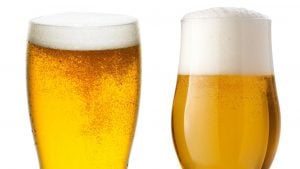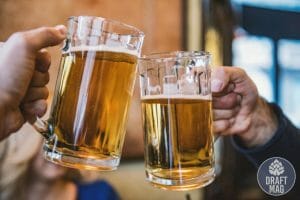West Coast IPA vs New England IPA: Comparing Two Top IPAs
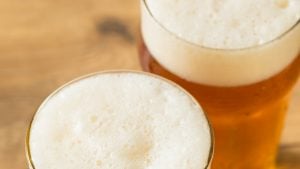 West Coast IPA vs New England IPA is the great war between these two Indian Pale Ales. While there are different kinds of IPAs, these two styles seem to stand out. The West Coast IPAs were the rage for several years, so the introduction of the New England IPAs (NEIPAs) provided a good level of rivalry.
West Coast IPA vs New England IPA is the great war between these two Indian Pale Ales. While there are different kinds of IPAs, these two styles seem to stand out. The West Coast IPAs were the rage for several years, so the introduction of the New England IPAs (NEIPAs) provided a good level of rivalry.
Read on as we uncover the difference between these popular beer styles.
What is West Coast IPA?
If you want to get precise, a West Coast IPA is an American-Style IPA. This is a golden-colored beer that recedes towards copper in specific versions. This is a top-fermented brew made using ale yeasts under higher temperatures, as is the case with all ales.
The brewing process is opposed to lagers which are bottom-fermented with lager yeast and cooler temps. With rare exceptions, the malts used are tuned into malted barley.
West Coast style IPA is famous for its strong hop aromas, intense bitterness, and citrus/piney aromas and tastes. For IPAs of this style, the hops are the main attraction. Hops cultivated in abundance on the West Coast, particularly in Washington State, are used to make the hopping.
Some brewers also use Southern hemisphere hops in some instances. The almost complete removal of the maltiness allows the hops’ bitterness to show through.
A standard West Coast style IPA is one that is not a double IPA or dry-hopped. The IBUs or bitterness units in these beers are usually between 50 and 70. However, those may edge up to 100 in some cases. Pliny the Elder is a classic example of a West Coast IPA, and it has an IBU of 100.
However, lovers of these beers often look beyond bitterness. The West Coast hops make it what it is today. The uniqueness of West Coast IPAs extends to their crystal-clear look with a bold feel with notes of pine, floral, citrus, and fruit. The Brewer’s Association definition clearly states the need for the West Coast IPA to have a bright fruity nature.
What is New England IPA?
Other official names for this IPA are Hazy IPA or Juicy IPA. It is one of the newest types of Indian Pale Ale on the block and beer lovers can’t seem to get enough of it; everyone seems to be talking about, drinking, and brewing it.
It’s brewed with top-fermenting ale yeasts, just like all ales and IPAs. NEIPA, on the other hand, frequently cuts its barley malts with oats, malted wheat, or other extras. Then, its brew isn’t filtered to get that hazy quality. This can give the beer additional depth and add a few more flavor notes.
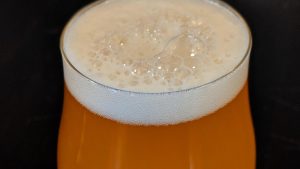 The hop scents are still powerful in these beers, but the IBUs have been reduced somewhat. This makes beers in this group more interesting. Moreover, some NEIPAs have low IBUs, as low as 30.
The hop scents are still powerful in these beers, but the IBUs have been reduced somewhat. This makes beers in this group more interesting. Moreover, some NEIPAs have low IBUs, as low as 30.
In terms of comparison, a draft Guinness beer has an IBU of around 45. As a result, these beers are more approachable to those who can’t handle too much bitterness.
We have a lot of variation in terms of what tastes are transmitted through the brew in those hops. Since the beer’s name is “juicy,” we’re sure you can figure out where this leads to: large quantities of hops used late in the brewing process give the beer its luscious fruit flavor. That juiciness frequently meets flavors of pine, citrus, floral, spice, or others, according to the Brewer’s Association’s description.
What Is the Difference Between West Coast IPA and New England IPA?
| Comparison Parameters | West Coast IPA | New England IPA |
| Brewing | Hops are added during the boiling. | Hops are added towards the end of the boil, after the boil, or during fermentation. |
| IBUs | 50-70 | 30 |
| Flavor, Taste, and Aroma | Pine resin, citrus, and tropical. | Fruit, juice, florals, and spice. |
The distinction between these IPA varieties may be traced back to where they came from, but more importantly, how they were created.
Both brew with a lot of hops, but in different ways and at different periods. For West Coast IPA, the bulk of those hops are added during the boiling. This point is where the heat extracts most of the bittering properties of the hops.
More hops are used towards the end of the boil, after the boil, or during fermentation in hazy IPAs. The haziness of NEIPAs provides a new mouthfeel to the beer. Moreover, the telltale haze appears due to the hop residue left suspended in the liquid.
Then, there is the grain particulate that comes from adjuncts like flaked oats and wheat. Some brewers also add other things to pump up the haze intentionally. As a result of the haziness, it has a silkier mouthfeel by nature.
A West Coast IPA isn’t necessarily more abrasive, but it has a more pronounced sharpness. Then there’s the question of which of those tasty notes is in the center vs. the background.
Fruit, juice, florals, and spice are prominent in NEIPAs.
In contrast, pine resin, citrus, and tropicals are prominent in West Coast IPAs.
West Coast IPA vs New England IPA: Can a West Coast IPA Be Hazy?
Older versions of West Coast IPAs have very little to no haze at all. However, modern generations are allowed to be unfiltered. They may also come with varying degrees of haze.
However, they need to maintain a solid balance in refreshing dryness and bitterness in their finish. This will enable proper distinction from the hazy IPAs because they tend to have similar hops flavor and aroma.
Other Popular IPA Styles You Should Look Out For
Let’s take a brief look at the world of IPAs. There are different kinds of IPAs that you can try, and the following descriptions will guide you.
– British IPAs
British IPAs are golden ales made with only British hops such as Fuggles and goldings. They have an earthy, grassy, and subtle citrus taste. They usually have a moisture content of six to seven percent and are bone dry.
– East Coast IPAs
The East Coast IPA is a relatively recent style that is based on the West Coast style. However, there is one significant difference – yeast.
East Coast brewers employ mutant, intricate British yeasts to focus the drinker on the hop scents and flavors. On the other hand, California brewers use clean, nearly flavorless yeasts to focus on the hop aromas and flavors.
As the sugar ferments, these yeasts provide a variety of scents and flavors, including stone fruit, banana, and tropical notes. The brewers employ it to balance out the powerful hop fragrances. They can use fewer hops, making the beers less bitter. Finally, they can also leave the beer foggy to give it a murky appearance and a fluffy feel.
– Double IPAs
Some people become tired of current IPAs as they become accustomed to their extreme bitterness. “More hops,” they chanted as they sought for the strongest aromas and the driest finishes.
Brewers responded by making bolder, hoppier beers, combining the sweetness of high alcohol and a high malt content with the bitterness of the hops. As a result, brewers have more freedom to experiment with hops and push them to their limits with Double IPAs.
– Session IPAs
After pursuing high ABVs and then the next big hop hit, some astute brewers made new conclusions. People who want to have more relaxed drinking sessions clamored for a probable reduction in alcohol content.
That’s what the session IPA does – it packs a punch of hops while remaining under five percent ABV. Session IPAs are cracker dry and dry-hopped to achieve the most scent for the least amount of bitterness, resulting in a beer that’s both palatable and flavorful.
FAQs
Why is a New England IPA Hazy?
The main reason for the colloidal haze in NEIPAs is the dry hopping method used for its brewing. This method involves the addition of hops during fermentation. Hops contain polyphenols that combine with the protein present in the beer to form the haze. However, you should note that this only happens when brewers use substantial amounts of hops in dry-hopping – a procedure employed for these craft beers.
Are Hazy IPAs Less Bitter?
Hazy IPAs are characterized by a careful combination of hops and malt. This also combines with less filtering before final packaging. Therefore, the end result is a beer with lower bitterness than other IPAs.
A hazy IPA typically has an IBU around the range of 45. On the other hand, West Coast IPAs may have their IBUs reaching the early 100s. Moreover, the hops character gives a juicier flavor to this style of beer.
Conclusion
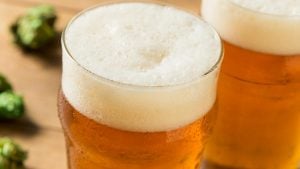 Both West Coast IPA and New England IPA exude the IPA flavor profile so, you can never go wrong with either one of them.
Both West Coast IPA and New England IPA exude the IPA flavor profile so, you can never go wrong with either one of them.
In this article, the major talking points were:
- West Coast style IPA is popular for its strong hops aroma, intense bitterness, and citrus/piney aromas and tastes
- New England IPAs are also delicious, with an intense hops aroma. However, they are far less bitter than their West Coast counterparts
- The difference between NEIPA and West Coast IPA lies in their brewing technique, haze, and bitterness
- West Coast IPAs can also be hazy, but they need to balance refreshing dryness and bitterness
- Other popular IPA styles include British, East Coast, Double, and Session IPAs
Most old-school lovers of craft beer continue to lean towards the West Coast style IPA, yet, the hazy IPA has brought more people into the craft beer world. In the end, the choice is up to you.


